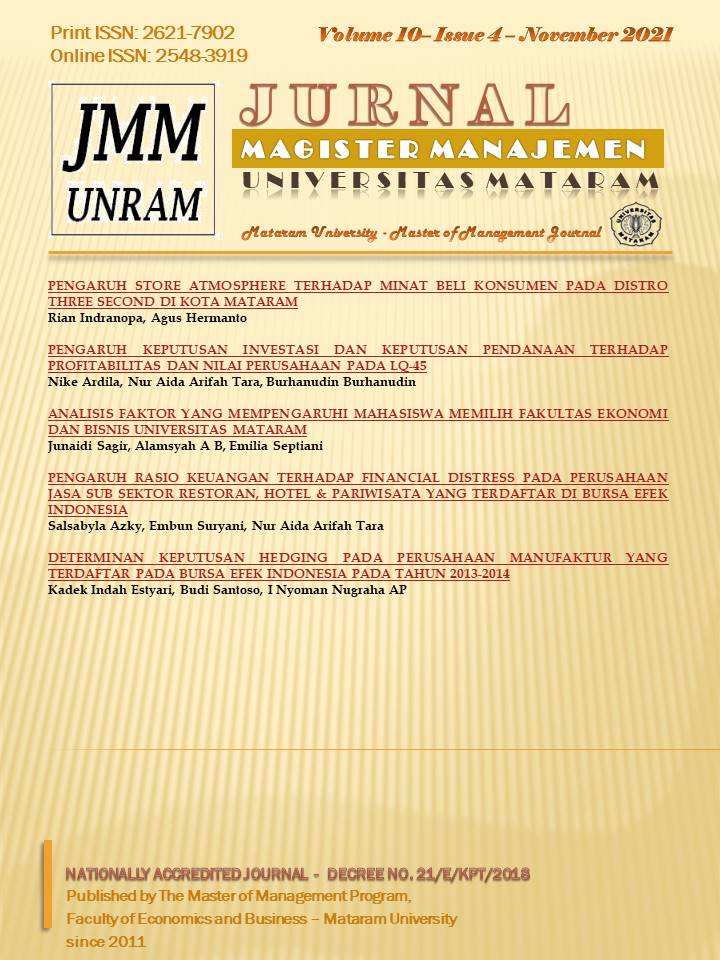PENGARUH RASIO KEUANGAN TERHADAP FINANCIAL DISTRESS PADA PERUSAHAAN JASA SUB SEKTOR RESTORAN, HOTEL & PARIWISATA YANG TERDAFTAR DI BURSA EFEK INDONESIA
DOI:
https://doi.org/10.29303/jmm.v10i4.691Abstract
This research aims to analysis the influence of profitability ratios proxied by Return On Assets (ROA), leverage ratios proxied by Debt to Asset Ratio (DAR), liquidity ratios proxied by Current Ratio (CR) and activity ratios proxied by Total Asset Turnover (TATO) on the prediction of financial distress on service companies of hotel, restaurant and tourism sub-sector listed on the Indonesia Stock Exchange period of 2015-2019. The criteria of financial distress in research were measured using the Interest Coverage Ratio (ICR) with a value criterion of less than one. Analysis method used in this research is logistic regression. The research results show that the profitability ratio had an effect on the prediction of financial distress. While the leverage ratio, liquidity ratio and activity ratio have no effect on the prediction of financial distress.References
Agustini, N. W., & Wirawati, N. G. P. (2019).Pengaruh Rasio Keuangan Pada Financial Distress Perusahaan Ritel Yang Terdaftar Di Bursa Efek Indonesia (BEI).E-Jurnal Akuntansi Universitas Udayana, 26(1), 251–80.
Aisyah, N. N., Kristanti, F. T., & Zultilisna, D. (2017). Pengaruh Rasio Likuiditas, Rasio Aktivitas, Rasio Profitabilitas, Dan Rasio Leverage Terhadap Financial Distress (Studi Pada Perusahaan Tekstil Dan Garmen Yang Terdaftar Di Bursa Efek Indonesia Tahun 2011-2015). E-Proceeding of Management, 4(1), 411.
Baldwin, C. Y., & Mason, S. (1983). The Revolution of Claim in Financial Distress: The Case of Massey Ferguson. The Journal of Finance, 38(2), 505–516.
Brahmana, R. K. (2007). Identifying Financial Distress Conditions in Indonesia Manufacture Industry.Journal Birmingham Business School, University of Birmingham, 5–51.
Brigham, E. F., & Daves, P. R. (2003).Intermediate Financial Management. Eight Edition. Ohio: Thomson South-Western.
Elloumi, F., & Gueyie, J-P. (2001). Financial Distress And Corporate Governance: An Empirical Analysis, Corporate Governance. The International Journal of Business in Society, 9(1), 88–108.
Fahmi, I. (2014). Analisis Laporan Keuangan. Bandung: Alfabeta.
Fraser, L. M., & Ormiston, A. (2008).Memahami Laporan Keuangan. Edisi Ketujuh. Jakarta: Indeks.
Hanifah, O. E., & Purwanto, A. (2013).Pengaruh Struktur Corporate Governance Dan Financial Indicators Terhadap Kondisi Financial Distress.Diponegoro Journal Of Accounting, 2(2), 1–5.
Kasmir.(2008). Analisis Laporan Keuangan.Edisi Pertama. Jakarta: RajaGrafindo Persada.
Kasmir.(2014). Analisis Laporan Keuangan. Jakarta: RajaGrafindo Persada.
Mujib, A., & Santoso, B. H. (2020).Pengaruh Rasio Keuangan Terhadap Prediksi Kondisi Financial Distress Perusahaan Perkebunan Di Bei.Jurnal Ilmu Dan Riset Manajemen, 9(1), 1–18.
Platt, H. D., & Platt, M. B. (2002).Predicting Corporate Financial Distress: Reflection on Choice Based Sample Bias.Journal of Economics and Finance, 26(2), 184–99.
Priyatnasari, S., & Hartono, U. (2019). Rasio Keuangan, Makroekonomi Dan Financial Distress: Studi Pada Perusahaan Perdagangan, Jasa Dan Investasi Di Indonesia. Jurnal Ilmu Manajemen, 7(4), 1005–16.
Putri, D. S., & Erinos N. R. (2020). Pengaruh Rasio Keuangan Dan Ukuran Perusahaan Terhadap Financial Distress.Jurnal Eksplorasi Akuntansi, 2(1), 2083–98.
Setiawan, H., & Amboningtyas, D. (2018). Financial Ratio Analysis For Predicting Financial Distress Conditions (Study on Telecommunication Companies Listed In Indonesia Stock Exchange Period 2010-2016). Journal of Management, 4(4).
Wruck, K. (1990). Financial Distress, Reorganization, and Organizational Efficiency. Journal of Financial Economics, 27, 419-444.
Sucipto, A. A., & Muazaroh. (2017). Kinerja Rasio Keuangan Untuk Memprediksi Kondisi Financial Distress Pada Perusahaan Jasa Di Bursa Efek Indonesia Periode 2009-2014. Journal of Business & Banking, 6(1), 81–98.
Widhiari, N. L. M. A., & Merkusiwati, N. K. L. A. (2015). Pengaruh Rasio Likuiditas , Leverage , Operating Capacity , Dan Sales Growth Terhadap Financial Distress. E-Jurnal Akuntansi Universitas Udayana, 11(2), 456–69.
Downloads
Published
How to Cite
Issue
Section
License
Copyright (c) 2021 Budiman Budiman

This work is licensed under a Creative Commons Attribution 4.0 International License.
- Authors retain copyright and grant the journal right of first publication with the work simultaneously licensed under a CC BY 4.0. This license allows authors to use all articles, data sets, graphics, and appendices in data mining applications, search engines, web sites, blogs, and other platforms by providing an appropriate reference. The journal allows the author(s) to hold the copyright without restrictions and will retain publishing rights without restrictions.
- Authors are able to enter into separate, additional contractual arrangements for the non-exclusive distribution of the journal's published version of the work (e.g., post it to an institutional repository or publish it in a book), with an acknowledgment of its initial publication in JMM.
- Authors are permitted and encouraged to post their work online (e.g., in institutional repositories or on their website) prior to and during the submission process, as it can lead to productive exchanges, as well as earlier and greater citation of published work (See The Effect of Open Access).










